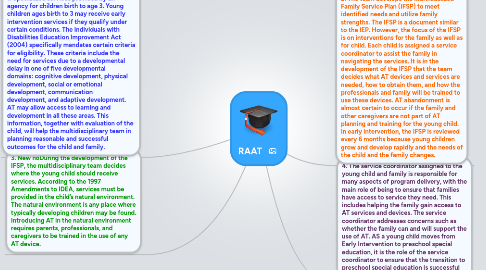RAAT
by Mario Stevenson

1. 3. New noDuring the development of the IFSP, the multidisciplinary team decides where the young child should receive services. According to the 1997 Amendments to IDEA, services must be provided in the child’s natural environment. The natural environment is any place where typically developing children may be found. Introducing AT in the natural environment requires parents, professionals, and caregivers to be trained in the use of any AT device.
2. 1. Specialized services provided by an agency for children birth to age 3. Young children ages birth to 3 may receive early intervention services if they qualify under certain conditions. The Individuals with Disabilities Education Improvement Act (2004) specifically mandates certain criteria for eligibility. These criteria include the need for services due to a developmental delay in one of five developmental domains: cognitive development, physical development, social or emotional development, communication development, and adaptive development. AT may allow access to learning and development in all these areas. This information, together with evaluation of the child, will help the multidisciplinary team in planning reasonable and successful outcomes for the child and family.
3. 4. The service coordinator assigned to the young child and family is responsible for many aspects of program delivery, with the main role of being to ensure that families have access to service they need. This includes helping the family gain access to AT services and devices. The service coordinator addresses concerns such as whether the family can and will support the use of AT. AS a young child moves from Early Intervention to preschool special education, it is the role of the service coordinator to ensure that the transition to preschool special education is successful for the child and family.
4. 2. The team develops the Individualized Family Service Plan (IFSP) to meet identified needs and utilize family strengths. The IFSP is a document similar to the IEP. However, the focus of the IFSP is on interventions for the family as well as for child. Each child is assigned a service coordinator to assist the family in navigating the services. It is in the development of the IFSP that the team decides what AT devices and services are needed, how to obtain them, and how the professionals and family will be trained to use these devices. AT abandonment is almost certain to occur if the family and other caregivers are not part of AT planning and training for the young child. In early intervention, the IFSP is reviewed every 6 months because young children grow and develop rapidly and the needs of the child and the family changes.


